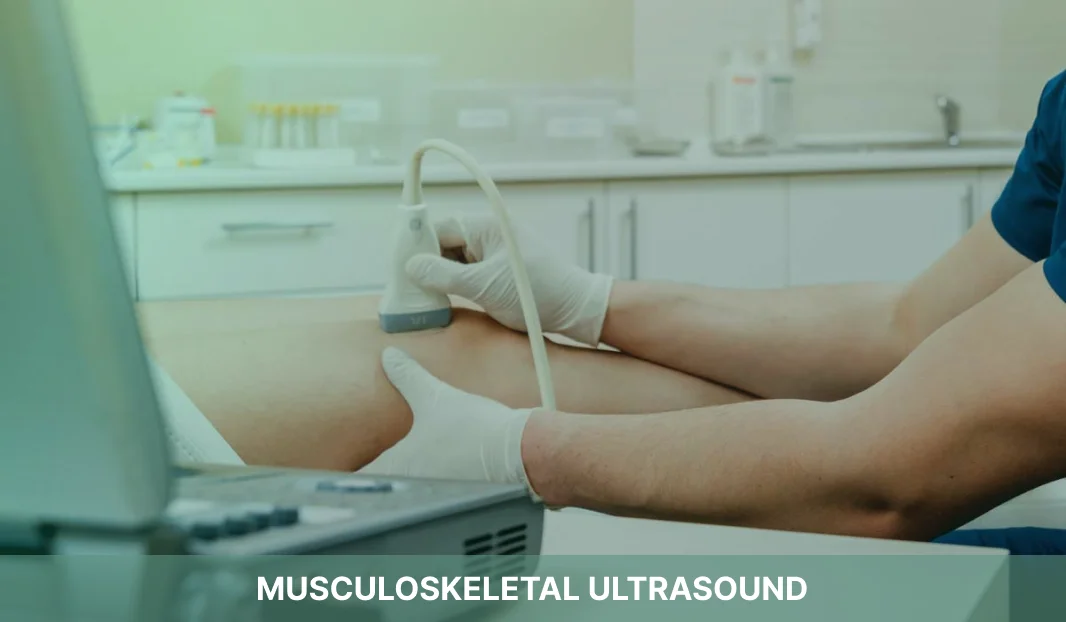Imagine a diagnostic tool that’s portable, painless, and provides real-time images of your musculoskeletal system – the intricate network of bones, muscles, tendons, ligaments, and joints that keep you moving. That’s the magic of Musculoskeletal Ultrasound!
For years, X-rays and MRIs have been the go-to options for examining musculoskeletal issues, whether it’s a sprained ankle from a weekend soccer game or persistent back pain from hours spent at a desk. Musculoskeletal ultrasound is the one solution to all musculoskeletal problems. Let’s understand how this unique technology makes it a game-changer in the field of musculoskeletal diagnostic Imaging service and treatment.
What is Musculoskeletal Ultrasound?
Musculoskeletal ultrasound, often referred to simply as MSK ultrasound, is a non-invasive imaging technique that provides a valuable window into the intricate workings of your musculoskeletal system. This system houses your muscles, tendons, ligaments, joints, and all the soft tissues throughout your body. It can even visualise blood flow within your blood vessels.
Comparison of Imaging Modalities
| Feature | MSK Ultrasound | X-ray | MRI |
|---|---|---|---|
| Radiation Exposure | None | Yes | None |
| Portability | High | Low | Low |
| Cost | Low to Moderate | Low | High |
| Real-Time Imaging | Yes | No | No |
| Soft Tissue Visualization | Excellent | Poor | Excellent |
| Dynamic Assessment | Yes | No | Limited |
How Does Musculoskeletal Ultrasound Work?
The magic behind MSK ultrasound lies in a small handheld device called a transducer. During the examination, a gel is applied to your skin, and the transducer is gently pressed against the area of interest. The transducer emits high-frequency sound waves that travel through the gel and into your body. These sound waves bounce back off various tissues, and the transducer picks them up. A computer then utilises these returning sound waves to create real-time images, allowing healthcare providers to visualise the internal structures of your musculoskeletal system.
How To Be Prepared Before a Musculoskeletal Ultrasound?
By preparing properly, you can help ensure that your musculoskeletal ultrasound goes smoothly and provides the most accurate results possible.
Here’s what you can expect before your MSK ultrasound appointment:
- Comfortable Clothing: Wear loose-fitting clothing to ensure easy access to the area undergoing examination. Avoid tight clothing or clothing with metal buttons or zippers, as these may need to be removed.
- Jewellery Removal: Please remove any jewellery in the area being examined to ensure optimal image quality.
- Medical History: If you have any relevant medical history, such as allergies or medications you’re taking, be sure to inform your doctor or technologist beforehand.
- Questions Welcome: Don’t hesitate to ask your doctor any questions you may have about the MSK ultrasound procedure or your condition.
What to Expect During Musculoskeletal Ultrasound Scan?
An MSK ultrasound is a straightforward procedure designed for your comfort.
Here’s what you can expect during an MSK ultrasound, ensuring you feel prepared and at ease throughout the process:
- The Team: Your MSK ultrasound may be performed by a radiologist, your orthopaedist or rheumatologist specialising in the musculoskeletal system, or a trained ultrasound technician.
- Positioning for Comfort: You’ll be positioned either sitting or lying down, depending on the location of the pain or other issue being examined. This ensures the healthcare professional can access the area of interest comfortably.
- Gel for Optimal Signal: A warm, lubricating gel will be applied to the transducer, the handheld device used for the ultrasound. This gel helps transmit and receive sound waves effectively, creating clear images.
- Real-Time Imaging Process: Once the gel is applied, the healthcare professional will gently press the transducer against your skin near the affected area. They will then slowly move the transducer across the area, capturing real-time images of your musculoskeletal structures.
- Movement May Be Required: In some cases, the healthcare professional may ask you to move the affected body part slightly. This helps them visualise the movement and function of your musculoskeletal system and correlate it with any pain or discomfort you might be experiencing.
What to Expect After Your Musculoskeletal Ultrasound?
By understanding what to expect after your musculoskeletal ultrasound, you can better prepare for the next steps in your healthcare journey and ensure you get the most out of your treatment plan.
Here’s what you can expect after your MSK ultrasound procedure:
- Results Discussion: Your doctor will share the results of your MSK ultrasound with you, typically within a short timeframe. In some cases, the radiologist who performed the exam may also discuss the findings with you directly.
- Next Steps: Based on the results, your doctor will discuss the next steps in your treatment plan. This may involve medication, physical therapy, follow-up imaging, or other interventions.
- Follow-Up Exams: If necessary, your doctor may recommend a follow-up MSK ultrasound to monitor your progress or assess a potential issue further. They will explain the rationale behind the follow-up exam and what to expect.
Why Choose Musculoskeletal Ultrasound?
Let’s delve into the reasons why MSK ultrasound is rapidly gaining popularity:
- Real-Time Visualisation: Unlike traditional X-rays or CT scans, which capture static images, MSK ultrasound provides dynamic visuals in real-time. This allows doctors to assess movement patterns, identify subtle abnormalities, and monitor how structures respond during specific actions.
- Painless and Radiation-Free: MSK ultrasound utilises sound waves to create images, making it a completely painless and radiation-free procedure. This is a significant benefit, especially for children, pregnant women, or patients who are sensitive to radiation exposure.
- Portable and Cost-Effective: Compared to bulky MRI machines, MSK ultrasound equipment is portable and can be used in various settings, including clinics and even at a patient’s bedside. It is also relatively cost-effective, making MSK ultrasound a more accessible diagnostic tool.
- Fast and Efficient: MSK ultrasound examinations are typically quicker than traditional imaging techniques, with results available immediately during the procedure. This results in shorter waiting times and faster diagnosis for patients.
What Are the Diagnostic Applications of Musculoskeletal Ultrasound?
Musculoskeletal ultrasound shines a light on a wide range of applications in diagnosing and managing various musculoskeletal conditions. Here are some common examples:
- Tendon Troubles: MSK ultrasound can pinpoint tears or inflammation (tendinitis) in various tendons, including the rotator cuff in the shoulder, the Achilles tendon in the ankle, and many others throughout the body.
- Muscle Matters: It can detect muscle tears, unusual masses, or fluid collections within muscles, providing valuable information for treatment planning.
- Ligament Laxity: Sprains or tears in ligaments can be identified, helping determine the severity of an injury.
- Joint and Bursa Issues: Inflammation or fluid buildup (effusions) within bursae (fluid-filled sacs cushioning joints) and joints themselves can be visualised, aiding the diagnosis of conditions like arthritis.
- Early Arthritis Detection: MSK ultrasound can detect early signs of rheumatoid arthritis, allowing for prompt intervention.
- Nerve in Distress: Nerve entrapment, such as carpal tunnel syndrome, can be identified by visualising abnormalities in nerve positioning.
- Soft Tissue Scrutiny: Both benign and malignant soft tissue tumours can be identified using MSK ultrasound.
- Cyst Solutions: Ganglion cysts, fluid-filled sacs in tendons or joints, can be visualised and diagnosed.
- Hernia Help: MSK ultrasound can detect hernias, and abnormal bulges of tissue pushing through muscle walls.
- Joint Injections: MSK ultrasound provides real-time guidance for joint injections. This ensures precise needle placement, optimising the effectiveness of treatment and minimising discomfort for the patient.
- Guiding Procedures: MSK ultrasound can be used to guide minimally invasive procedures like needle biopsies or fluid drainage around joints, improving accuracy and reducing complications.
- Presence of Foreign Body: Splinters, glass, or other foreign objects lodged in soft tissues can be located and visualised.
- Developmental Assessments: MSK ultrasound plays a role in assessing hip development in infants, including dislocations and dysplasia. It can also identify fluid buildup in a child’s painful hip joint.
- Infant Concerns: MSK ultrasound can help diagnose neck muscle abnormalities in infants with torticollis (twisted neck) and identify soft tissue masses (lumps or bumps) for further investigation.
What Are the Therapeutic Applications of Musculoskeletal Ultrasound?
The benefits of MSK ultrasound extend beyond diagnosis. It plays a crucial role in various therapeutic interventions for musculoskeletal conditions:
- Physical Therapy: MSK ultrasound helps physical therapists visualise muscle activation patterns and identify movement dysfunctions. This information can be used to tailor therapy programs for optimal rehabilitation.
- Pain Management: MSK ultrasound-guided injections of medications directly target areas of inflammation, offering fast and effective pain relief.
- Ultrasound Therapy: Therapeutic ultrasound utilises sound waves to promote tissue healing, reduce inflammation, and improve blood flow. This can be beneficial for managing pain and accelerating recovery from injuries.
Key Takeaway
Musculoskeletal ultrasound is a powerful tool with the potential to enhance mobility. It can help reduce pain, getting you back to living an active lifestyle. If you’re experiencing musculoskeletal discomfort, exploring the benefits of musculoskeletal ultrasound could be your pathway to optimal health. Consult with a healthcare provider to determine if MSK ultrasound is the right choice for you.
Your One-Time-Solution to Musculoskeletal Pain
At Radiology Imaging Solutions, we specialise in providing comprehensive Health Care Image Services including musculoskeletal procedures performed under precise imaging guidance. Our team of compassionate and experienced radiologists is dedicated to delivering top-quality care with a difference. By combining advanced technology with personalised attention, we ensure accurate diagnoses and effective treatments. Contact us today to experience the expertise and care that set us apart in the field of musculoskeletal ultrasound imaging.

